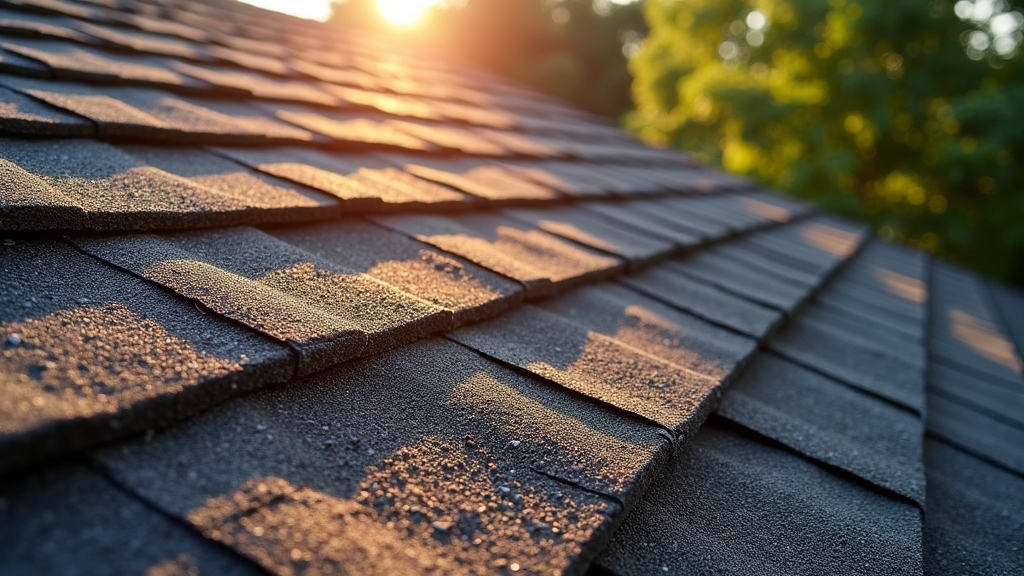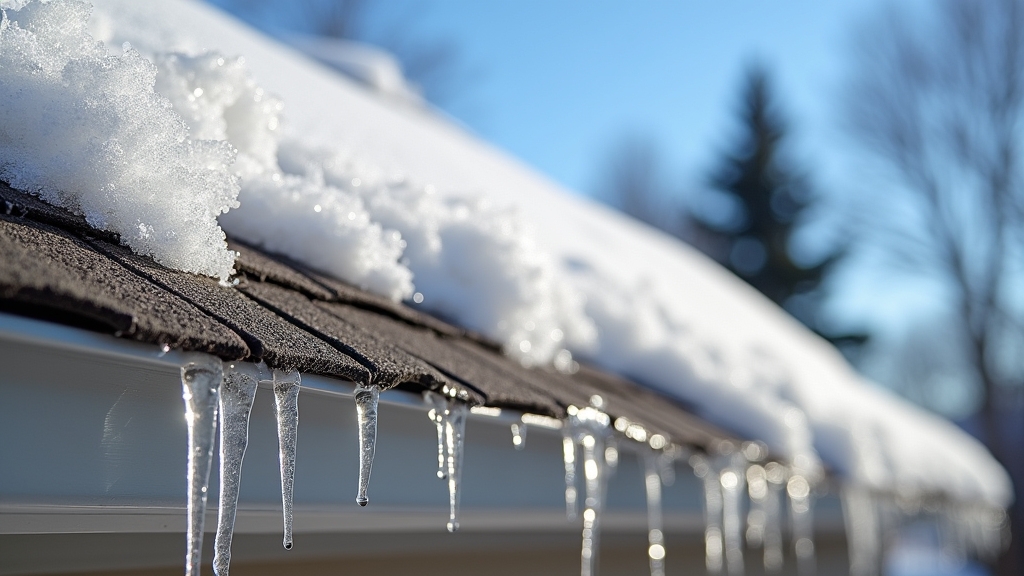Troy’s hot, humid summers and strong UV dry out binders, fatigue materials, and loosen seals. Thunderstorms drive wind-blown rain into weak flashing and clogged gutters, causing leaks and fascia damage. Winters bring freeze–thaw stress and ice dams from uneven roof temperatures, pushing meltwater under shingles. Asphalt performs adequately, with architectural shingles resisting wind and hail better; metal sheds ice well. Proactive maintenance—seasonal inspections, ventilation, and drainage—extends lifespan. The following sections explain practical steps and material choices for Troy’s climate.
Key Takeaways
- Troy’s hot, humid summers accelerate UV-induced shingle brittleness, granule loss, and sealant fatigue, shortening roof life.
- Freeze-thaw cycles and lake-effect snow stress materials, forming ice dams that drive meltwater under shingles and cause leaks.
- Wind-driven thunderstorms exploit weak flashing and lifted shingles, leading to water intrusion and fascia damage.
- Proper attic ventilation stabilizes roof temperatures, reducing condensation, ice dam risk, and thermal shock on shingles.
- Seasonal inspections and clear gutters/downspouts prevent minor defects and overflow from becoming lifespan-shortening failures.
Heat, Humidity, and UV: Summer Stress on Roofing Materials

July sun over Troy turns rooftops into heat sinks, and the combined load of high temperatures, humidity, and UV radiation accelerates material fatigue. Prolonged UV exposure dries binders in common roofing materials, making shingles brittle and prone to surface granule loss.
Heat cycles expand and contract laminates, loosening seals and fasteners. Humidity raises moisture content in decks and underlayments, encouraging warping and undermining adhesion. Dark surfaces reach higher temperatures, compounding stress; light, reflective options reduce thermal gain.
Heat and humidity strain roofs: seals loosen, adhesion falters—choose lighter, reflective surfaces to reduce thermal stress.
Ventilation matters: adequate attic airflow lowers peak temperatures, limiting distortion and premature aging. Sealants and flashing also degrade faster under UV.
Practical summer maintenance includes inspecting vents, replacing cracked sealant, confirming shingle adhesion, clearing debris that traps heat, and documenting wear to plan timely, cost-effective repairs.
Thunderstorms and Downpours: Managing Heavy Rain and Runoff

When thunderstorms sweep across Troy, roofs face abrupt, high-volume rainfall that tests every pathway water can find. Intense downpours exploit weak flashing, undersized gutters, and clogged valleys, leading to leaks, soffit rot, and fascia damage.
Effective rainwater management begins with adequate roof slope and intact underlayment to shed water quickly. Equally important are drainage solutions sized for local storm intensity: wider gutters, larger downspouts, and sufficient outlets to prevent overflow.
Regular maintenance strengthens performance. Clearing debris from gutters and scuppers, resealing penetrations, and reattaching loose hangers keep water moving.
Splash blocks or downspout extensions direct flow away from foundations, reducing wall saturation and basement seepage. After severe storms, prompt inspections identify displaced shingles, hail dents, and loosened fasteners before minor moisture intrusion becomes structural damage.
Freeze–Thaw Cycles: Winter Damage and Ice Dams

Freeze–thaw cycles in Troy set the stage for ice dam formation along eaves, forcing meltwater under shingles.
Repeated expansion and contraction increase shingle cracking risks, accelerating leaks and premature wear.
Strategic insulation and ventilation—especially air sealing and balanced attic airflow—serve as primary preventive measures.
Ice Dam Formation
Ice crystals along roof edges signal a common winter hazard in Troy: ice dams. They form when attic heat escapes, warming the upper roof and melting snow. Meltwater flows downward, reaches colder eaves, and refreezes into a ridge that traps water. Standing water then seeks entry under shingles and into seams, wetting sheathing and insulation.
The core drivers are uneven roof temperatures, inadequate roof insulation, and insufficient ventilation. Valleys, north-facing slopes, and gutters are frequent initiation points.
Mitigation focuses on temperature balance: improve air sealing, add roof insulation to reduce heat loss, and maintain clear soffit and ridge ventilation. Carefully applied ice melt products can open channels, but they are temporary measures.
Long-term control includes sealing attic bypasses and managing rooftop snow depth.
Shingle Cracking Risks
While ice dams trap water at the eaves, the broader winter pattern that follows threatens the shingles themselves. In Troy, frequent freeze–thaw cycles push moisture beneath tabs and into microgaps. When temperatures drop, that trapped water expands, prying granules loose and stressing the asphalt matrix.
Repetition creates fissures that propagate along nail lines and exposed edges, lowering shingle durability and inviting leaks once meltwater returns.
Thermal shock compounds the issue. Sunlit afternoons warm brittle, cold-soaked shingles rapidly, causing surface curvature and fatigue. Older or UV-weakened shingles lose elasticity, making cracks more likely under wind lift or foot traffic.
Effective cracking prevention relies on limiting moisture intrusion, maintaining secure fasteners, and replacing compromised shingles promptly so small fractures do not cascade into widespread surface failure during late-winter thaws.
Preventive Insulation Tips
A well-planned insulation and ventilation strategy is the backbone of preventing ice dams and freeze–thaw damage in Troy’s climate. When attic temperatures stay close to outdoor levels, snow melts less on the roof surface, reducing refreezing at the eaves. Properly chosen insulation materials—such as high-R fiberglass batts, dense-pack cellulose, or spray foam—limit heat loss into the attic and increase energy efficiency.
Air sealing is equally important. Sealing penetrations around light fixtures, chimneys, and bath vents prevents warm, moist air from escaping into the attic and condensing.
Balanced ventilation, using soffit intakes and a ridge vent, sustains uniform airflow that carries away heat and humidity. Adding an ice and water shield at eaves, improving drainage, and maintaining clear gutters further mitigate ice dam formation and cyclic winter stress.
Wind Events: Uplift, Loose Shingles, and Flashing Failures
High winds in Troy subject roofs to uplift forces that can break sealant bonds and start shingle displacement.
Once shingles lift or crease, wind-driven rain exploits gaps, turning minor looseness into leaks.
Flashing around chimneys, walls, and valleys is especially vulnerable after storms, where bent metal or failed sealants allow water intrusion.
Uplift Forces on Shingles
Despite calm appearances, wind imposes significant uplift forces on asphalt shingles, prying at their edges and weakening the adhesive bond meant to keep them sealed. As gusts accelerate over a roof plane, pressure drops on the surface while higher pressure remains beneath, creating a lifting effect. Repeated cycles fatigue sealant strips, reducing shingle durability and wind resistance over time.
In Troy, squall lines and lake-influenced storms produce rapid direction changes and turbulent eddies that concentrate uplift along ridges, eaves, and gable edges. Once seals partially release, shingles flutter, nail holes elongate, and fasteners lose clamping power.
Cold snaps harden sealants, while summer heat can soften them, both conditions diminishing bond strength. Proper nailing patterns, compatible sealant chemistry, and adequate roof ventilation help maintain edge adhesion and limit uplift-driven damage.
Flashing Leaks After Storms
Wind-lift that loosens shingles also exposes and stresses roof flashing, turning minor separations into leak paths after storms.
In Troy, gust-driven uplift pries at step, valley, and chimney flashing, breaking sealants and enlarging fastener holes. Water then tracks behind siding or under shingles, appearing as ceiling stains days later.
Proper flashing installation—correct laps, fastener placement, and compatible sealants—reduces this risk, but aging metals and prior patchwork often fail under repeated wind events.
Proactive storm preparedness helps: homeowners can schedule post-storm inspections and address small gaps before the next front arrives.
- Inspect step and counter-flashing joints for lifted edges and cracked sealant.
- Check valleys and skylight curbs for displaced metal or fasteners.
- Re-secure loose shingles that expose flashing seams.
- Document damage, then prioritize professional repair.
Material Performance in Troy’s Climate: Asphalt, Metal, and More
Although Troy experiences a mix of lake-effect snow, freeze-thaw cycles, summer heat, and occasional high winds, roofing materials perform predictably when matched to those stresses.
Asphalt shingles remain common because asphalt durability is adequate when granules resist UV and the mat stays flexible through temperature swings. Thicker architectural shingles often outlast 3-tab options under hail and wind gusts.
Metal panels excel in ice-shed and thermal cycling; metal longevity reflects corrosion-resistant coatings, tight seams, and secure fastening that resists uplift.
Slate and tile offer strong service lives but require robust framing and careful installation to handle snow loads.
Wood shingles can perform, yet moisture cycling and algae risk shorten outcomes.
Synthetic composites balance impact resistance, lighter weight, and stable performance across seasons.
Proactive Maintenance: Seasonal Inspections, Ventilation, and Drainage Strategies
When Troy’s seasons swing from lake-effect snow to humid summers, proactive maintenance keeps roofs performing as designed.
Consistent seasonal inspections identify small defects before moisture, heat, or freeze-thaw cycles magnify them. Proper ventilation strategies balance intake and exhaust, stabilizing attic temperatures, reducing ice dams, and limiting condensation that degrades decking and insulation.
Effective drainage techniques move water off the roof quickly, protecting seams, fasteners, and fascia. Prompt, proactive repairs close penetrations, reseal flashings, and correct minor sagging to prevent structural fatigue.
- Schedule seasonal inspections after thaw and after leaf drop to assess shingles, flashing, and sealants.
- Implement ventilation strategies that achieve manufacturer-recommended airflow ratios.
- Maintain gutters, downspouts, and scuppers; verify slope and clear debris.
- Prioritize proactive repairs for emergent leaks, lifted edges, and compromised fasteners.
Frequently Asked Questions
How Does Tree Coverage in Troy Neighborhoods Impact Roof Lifespan?
Tree coverage in Troy neighborhoods can extend or shorten roof lifespan. Shade effects reduce UV damage and cooling loads, yet prolonged moisture, debris accumulation, and moss growth accelerate deterioration. Nearby tree roots indirectly contribute by destabilizing structures, causing drainage issues and facilitating leaks.
Are Local Building Codes Changing Roof Material Choices in Troy?
Yes. Local building codes increasingly influence roof material choices in Troy, pushing contractors toward sustainable materials and stricter code compliance. Updates emphasize fire ratings, wind uplift, energy efficiency, and reflective surfaces, prompting shifts from traditional asphalt to metal, composites, and cool-roof systems.
Do Attic Insulation Levels Affect Roofing Warranties in Troy?
Yes. Manufacturers often condition roofing warranties on proper attic insulation and ventilation. In Troy, inadequate insulation causing condensation, ice dams, or heat buildup can void coverage. Homeowners should document insulation R-values and ventilation compliance to preserve roofing warranties and performance.
How Do Nearby Industrial Emissions Influence Roof Aging in Troy?
Nearby industrial emissions accelerate roof aging in Troy by depositing acidic residues and particulates. These emission sources intensify UV degradation, corrode metal fasteners, embrittle shingles, and stain membranes. Pollution effects also increase cleaning frequency, shorten warranties, and necessitate protective coatings and vigilant maintenance.
What Insurance Discounts Exist for Weather-Resilient Roofs in Troy?
Weather-resilient roofs in Troy often qualify for discounts under an insurance policy, especially impact-resistant roof types (Class 3 or 4), reinforced shingles, or metal systems. Insurers may offer premium reductions after inspection, documentation, and compliance with local building standards.
Final Thoughts
Troy’s climate tests every roof with seasonal extremes—from UV-heavy summers to icy winters and storm-driven rain. While no material is immune, consistent upkeep makes the difference between early replacement and decades of service. Balanced attic ventilation, clear gutters, and timely flashing repairs are the first line of defense. Choosing durable systems such as architectural asphalt or metal roofing further safeguards against heat fatigue, freeze-thaw stress, and high winds. Homeowners who plan seasonal inspections and maintain proper drainage preserve both structure and efficiency year-round.
Don’t wait for the next storm to expose roof weaknesses. Contact Troy Roofing Pros for a professional roof inspection or roof replacement. Explore our services for residential and commercial properties, or reach out through our contact page for a free estimate. Call (248) 587-8250 or email admin@roofingtroy.com today.
